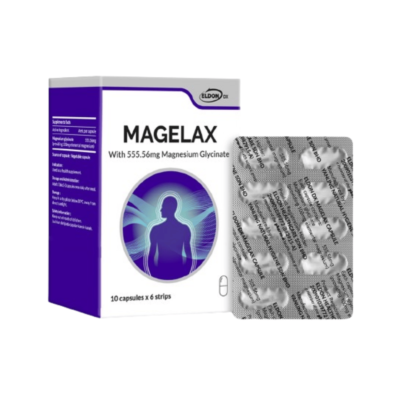This health article has been professionally reviewed by Dt Chen Zi Xin MAHPC(DTN)01583, a registered dietitian of the Malaysian Dietitians’ Association (MDA).
Choosing the Right Magnesium
We understand how vital magnesium is for the human body, but have you ever considered
that not all magnesium supplements are created equal?
Try looking closely at the label of a magnesium supplement, you may have noticed more than
just the dosage of elemental magnesium.
The form in which magnesium is delivered is equally important, as it significantly affects how
well the mineral is absorbed and utilized by the body. Additionally, some magnesium
complexes may offer added health benefits beyond magnesium itself.

The form of magnesium can be broadly grouped into four (4) categories based on their solubility and structure:
- Inorganic insoluble salts, such as Magnesium Oxide, Magnesium Carbonates,
Magnesium Hydroxides - Inorganic soluble salts, such as Magnesium Chloride, Magnesium Sulfates
- Organic soluble salts, such as Magnesium Citrates, Magnesium Lactates, Magnesium
Gluconates - Organic soluble complexes, such as Magnesium Glycinate
The bioavailability of magnesium compounds can be ranked in descending order as follows:
organic soluble complexes > organic soluble salts > inorganic soluble salts > inorganic insoluble
salts.
Types of Magnesium and How They are Being Used
The bioavailability of magnesium, meaning how much of it our body can actually absorb and
use, largely depends on how well the magnesium salt dissolves in water. Water solubility plays
a key role in how easily magnesium is absorbed in the digestive system. Here is a closer look
at the different types of magnesium salts and how their solubility affects absorption and
function:
1. Inorganic Insoluble Salts – A common example is magnesium oxide. This form has low water solubility; despite its high elemental magnesium content, its poor absorption makes it less effective for addressing deficiencies (1). However, magnesium oxide is often used for relieving constipation and occasional indigestion, due to its osmotic effect in the gut (2).
2. Inorganic Soluble Salts – An example here would be Magnesium Chloride dissolves well in water, allowing better absorption than magnesium oxide (3). Magnesium Chloride is often used for quickly restoring magnesium levels and supporting hydration, especially in clinical or topical applications.
3. Organic Soluble Salts – For example, magnesium citrate, which is highly soluble and generally well absorbed by the digestive system. It is commonly used to treat constipation due to its gentle laxative effect (4).
4. Organic Soluble Complexes – Prime example here would be Magnesium Glycinate, which is considered one of the most bioavailable forms of magnesium (5). This is due to its unique structure, where magnesium is chelated (bound) to two molecules of the amino acid glycine. Glycine helps magnesium cross into the brain through specific transport systems, which may boost magnesium’s effects on the nervous system (6). The combination of magnesium and glycine provides synergistic support for neurological health (7). This pairing may be particularly beneficial in managing conditions such as migraine headaches, insomnia, dementia, Parkinson’s disease, and restless leg syndrome (8).
Overall, it appears that organic magnesium formulations, like Magnesium Glycinate, are better
absorbed than inorganic ones (9). For optimal results, the right form should align with your
specific health goals and individual digestive tolerance. Learn more about Magnesium
Glycinate here!

Reference:
- Pardo, M. R., Garicano Vilar, E., San Mauro Martín, I., & Camina Martín, M. A. (2021). Bioavailability of magnesium food supplements: A systematic review. Nutrition, 89, 111294. https://doi.org/10.1016/j.nut.2021.111294
- National Library of Medicine. (2024, June 20). Magnesium oxide. MedlinePlus. https://medlineplus.gov/druginfo/meds/a601074.html
- Firoz, M., & Graber, M. (2001). Bioavailability of US commercial magnesium preparations. Magnesium research, 14(4), 257–262.
- National Library of Medicine. (2019, April 15). Magnesium citrate. MedlinePlus. Retrieved April 29, 2025, from https://medlineplus.gov/druginfo/meds/a619019.html
- Hartle, J. W., Morgan, S., & Poulsen, T. (2016, April). Development of a model for in-vitro comparative absorption of magnesium from five magnesium sources commonly used as dietary supplements. The FASEB Journal, 30(1 Suppl), 128.6. https://doi.org/10.1096/fasebj.30.1_supplement.128.6
- Tachikawa, M., & Hosoya, K. (2011). Transport characteristics of guanidino compounds at the blood-brain barrier and blood-cerebrospinal fluid barrier: Relevance to neural disorders. Fluids and Barriers of the CNS, 8, 13. https://doi.org/10.1186/2045-8118-8-13
- Kirkland, A. E., Sarlo, G. L., & Holton, K. F. (2018). The Role of Magnesium in Neurological Disorders. Nutrients, 10(6), 730. https://doi.org/10.3390/nu10060730
- Schwalfenberg, G. K., & Genuis, S. J. (2017). The Importance of Magnesium in Clinical Healthcare. Scientifica, 2017, 4179326. https://doi.org/10.1155/2017/4179326
- Schuchardt, J. P. & Hahn, A. (2017) Intestinal absorption and factors influencing bioavailability of magnesium−an update. Curr. Nutr. Food Sci., 13, 260–278.







